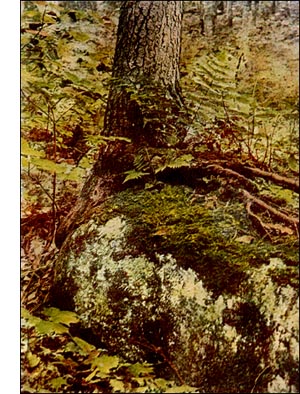Mosses
 If plants are small and green, with leafy stems, and have the habit of living in such close proximity as to form velvety cushions, (Ceratodon purpureum) one may suspect them of being mosses, but if they have this habit of growth, or grow in clusters resembling tiny ferns or miniature trees and bear their spores in little cases opening by lids, one may feel confident that they are the true mosses as distinguished from hepatics.
If plants are small and green, with leafy stems, and have the habit of living in such close proximity as to form velvety cushions, (Ceratodon purpureum) one may suspect them of being mosses, but if they have this habit of growth, or grow in clusters resembling tiny ferns or miniature trees and bear their spores in little cases opening by lids, one may feel confident that they are the true mosses as distinguished from hepatics.All true mosses produce their spores in a spore-case of one shape or another which opens, with few exceptions, by a lid. The spore-case may be situated at the summit of the stem of the moss-plant or on one side of the stem. It may or may not be supported upon a pedicel (seta).
Many species of moss have two rows of teeth about the rim of the spore-case, while some have one row and some have none. The teeth may vary greatly in shape and number; as a rule, there are four, sixteen, thrity-two or sixty-four.
Genus Amblystegium
Genus Andraea
Genus Anomodon
Genus Archidium
Genus Astomum
Genus Aulacomnium
Genus Barbula
Genus Bartramia
Genus Brachythecium
Genus Bruchia
Genus Bryum
Genus Buxbaumia
Genus Calliergon
Genus Catharinea
Genus Ceratodon
Genus Climacium
Genus Ctenium
Genus Dicranella
Genus Dicranum
Genus Diphyscium
Genus Ditrichum
Genus Encalypta
Genus Euhypnum
Genus Eurhynchium
Genus Fissidens
Genus Fontinalis
Genus Funaria
Genus Georgia
Genus Grimmia
Genus Gymnostomum
Genus Harpidium
Genus Hedwigia
Genus Hylocomnium
Genus Hypnum
Genus Leptobryum
Genus Leucobryum
Genus Mnium
Genus Neckera
Genus Octoblepharum
Genus Orthotrichum
Genus Phascum
Genus Physcomitrium
Genus Plagiothecium
Genus Pleuridium
Genus Pleurozium
Genus Pogonatum
Genus Polytrichum
Genus Pottia
Genus Racomitrium
Genus Schistostega
Genus Sphaerangium
Genus Splachnum
Genus Splendens
Genus Tetradontium
Genus Tetraplodon
Genus Tortula
Genus Trematodon
Genus Ulota
Genus Webera
Genus Weisia
Peat Mosses
Polytrichaceae